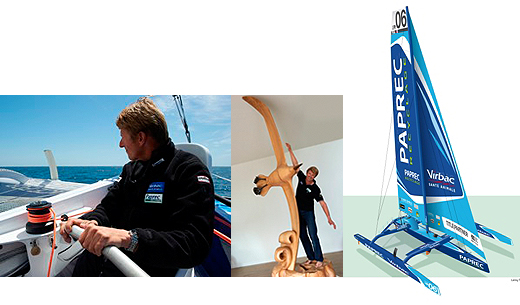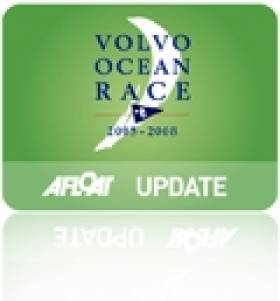Displaying items by tag: Damien Foxall
Foxall Poised to Win Volvo Ocean Race on Home Waters
#VOR – One of Ireland's most famous and most fearless ocean sailors, Kerry born Damian Foxall, is edging ever closer to realising the dream of a lifetime in what would be a moment of national triumph when the Volvo Ocean Race ends on Galway Bay.
Foxall is watch-leader on the battling French boat 'Groupama', overall leader and current favourite to win the gruelling 39,000-mile round the world race. He has played what has been spoken of as "an inspiring role" in the boat's success so far in the race.
"The Irish Examiner" described Damian Foxall, who now lives in France, as "unquestionably Ireland's finest ocean racing sailor whose name is whispered with awe among sailing's elite. He has also been called Ireland's "most capped" sailor having won a string of the world's most famous sailing races.
Now as the 2011-2012 Volvo Ocean Race enters its final decisive phase – the six boat fleet will power its way into Galway Bay in the early hours of Tuesday morning - Foxall is poised to win sailing glory and to hear the roar of the crowd and the ringing rounds of applause in his ears.
The last time Damian heard that roar, mingled with the strains of the beguiling "The Galway Girl", was in 2009 when the "Green Dragon", on which he was watch leader, arrived in the city to a rapturous 3am stop over reception. It was a reception the like of which has never been seen before in the race history. The Green Dragon, the Chinese-Irish entry, took a podium 3rd place that night after racing across the Atlantic from Boston.
Three years later, Foxall's boat "Groupama", skippered by the legendary French sailor Franck Cammas is tightening its grip on what has been one of the toughest Volvo Ocean Races and is moving every closer to overall victory.
"Camas already has "one hand on the trophy" race commentators in Lorient said after "Groupama" snatched a vital hometown victory in the in-port race on Saturday increasing its lead on its nearest rival, the US entry, Puma to 25 points. "Groupama" now has 225 points ; Puma 200; Camper (Spain/New Zealand) 196 and . Telefonica (Spain) 194 .
The final 450 mile leg of the race from Lorient to Galway, which is now under way, carries 30 points and an in port race in Galway a further 6. The final sprint to Galway could, according to race analysts, be one of the toughest and hardest fought yet.
For Foxall, this will be his eighth race around the world and the fourth time he has taken part in the Volvo Ocean Race. He admits he is nervous about winning in front of a home crowd. Speaking in Lorient he said "It's our race to lose and anything but overall victory would be a disaster for us," the Derrynane native said. "It is totally possible to lose the race from here."
"Our job now is very different to the first three-quarters of the race when we sailed all out," cautions Foxall. "Now we have to be very aware of risk management, we have to keep our noses clean and resist pressure from Ken Read on Puma, our nearest threat." A basic failure of critical equipment causing Groupama to finish last into Galway could be enough to give the advantage to Read. Nevertheless, the prospect of a repeat of the 2009 race stop-over is causing great anticipation in the race fleet. "It's going to be big. Throughout the race, the sailors and shore-teams who were in Galway last time have all been talking about their incredible experience there. We're all aware of the extraordinary effort being made in Ireland this time so we're looking forward to it." Other crew looking forward to a special welcome in Galway include Cork sailor Justin Slattery who is bowman on " Abu Dhabi Ocean Racing". It's skipper Ian Walker was skipper of Ireland's Green Dragon in 2008-2009 . He too has fond memories of the celebrations and the atmosphere in Galway docks for the dramatic night-time arrival of the fleet in the 2008-09 race. Justin Slattery who was bowman on the 2006-2006 Volvo Ocean Race winner ABN-AMRO One, and Damian Foxall both recall that they had never seen such race finish receptions.
Writing about that night in his book "Ocean Fever", Foxall recalled "It was 3am in the morning and the crew expected to be greeted by a few die hard supporters but in fact it was more like All Ireland final day."
"Out of the darkness, a RIB pulled up beside us, her crew dressed for offshore conditions and all cheering madly. Nice welcome, we thought. But as we crossed the bay, the fleet around us grew and by the time we were getting closer to the port where the channel narrows, the fleet was huge: you could have walked from one boat to another and in the middle of the night. And we were still trying to race." There was more to come. In the dim moonlight, as the fleet crept towards Galway docks, the Green Dragon crew could just make out the enormous crowd lining every spare bit of space on the docks. "We could see the sheer scale of 9,000 people gathered at three o'clock in the morning. We never expected this."
Foxall has won some of the world's top races including the 2007/2008 Barcelona World Race sailing with co-skipper Jean Pierre Dick on the Open 60 Paprec-Virbac.
He completed a world record circumnavigation in early 2004 with Steve Fossett on the G-Class catamaran Cheyenne. He was named Sailor of the Month by Afloat Magazine in March 2004.
New Challenge for Foxall's World Race Partner
Why have you decided to choose the MOD70 as of 2013?
"I found it annoying to see albatrosses overtaking me in the great south. It is now time for me to overtake them! This is a new leg in my sailing life which I'm going to cross flying over the water. I am fascinated by speed at sea. Both my sponsors and I are keen on new challenges. We are driven by a taste for adventure and enterprise. The MOD70 project is international and it corresponds to the development of my two major sponsors. From a racing point of view, I am going to find myself sailing with a crew which I enjoy. I am also going discover a new boat, meet new people, and follow new paths. It's really exciting!"

How are you going to get to grips with the multihull?
"Today, I am not a specialist in 70' multihulls, in the same way as I was not specialist in 60' monohulls in 2001. So there is the stimulating side of tackling a little-known field and doing everything in my power to get to grips with it. I like to challenge myself, work with a team, move forward and achieve an objective. The crews in the America's Cup have shown that you can go from monohulls to multihulls successfully. Through work with these boats they came to u nderstand things and are now very good. I am not worried. There will be a learning period, but we will be fighting on equal terms very quickly."
When does the project begin?
"With the commitment of my sponsors behind me, we can launch this project as of now and take the fourth and last French licence. At the moment, the Vendée Globe 2012 is my major goal. I have been working relentlessly for the last 10 years to try and win it. There is a time for everything. At the finish in Sables d'Olonne in 2013, I will go from one hull to three hulls to prepare for the new round-the-world on the MOD70."
Calendar 2013 – 2015
• March 2013: first sailing trips for PAPREC-VIRBAC 70
• May - June 2013: European Tour
• October 2013 / April 2014: start of the Ocean World Tour (round-the-world crew race in legs)
• August 2014 : Krys Ocean Race (Atlantic – Brest / New York crossing)
• 2015: One European Tour and one Ocean Race

























































